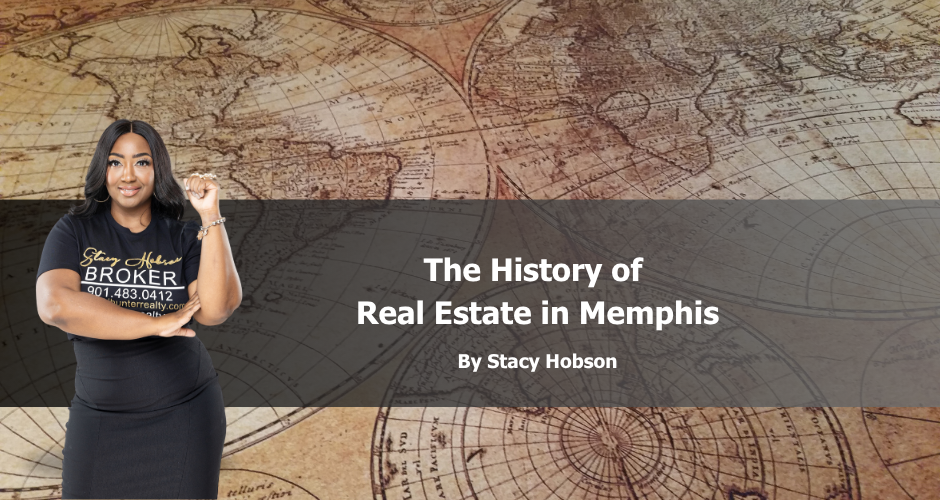Published October 15, 2025
The History of Real Estate in Memphis

Memphis has a rich and complex history, and tracing its real estate evolution offers a window into the the city’s growth, culture, and resilience. From riverfront beginnings to roaring urban expansion, here’s how Memphis real estate developed over time.
Early Foundations (Pre-1800s to 1820s)
- Long before European settlers arrived, the area that would become Memphis was inhabited by indigenous cultures such as the Mississippian civilization.
- The land for what is now West Tennessee was acquired by the U.S. government from the Chickasaw in the 1818 Jackson Purchase, opening it for settlement.
- In 1819, Memphis was founded by John Overton, James Winchester, and Andrew Jackson. They laid out a grid of streets and public squares—Market, Court, Exchange, Auction—that still influence downtown’s layout today.

Growth, Commerce & Challenges (Mid-1800s to Late 1800s)
- Memphis’s position on the Mississippi River made it a natural hub for cotton trade and shipping. Real estate along the riverfront and near rail lines increasingly gained value.
- The city survived the Civil War relatively intact but soon faced other challenges. Epidemics of Yellow Fever in 1878 and 1879 devastated the population—thousands fled or died—so much so the city dissolved its charter for a time.
- During that period of depopulation, some buyers saw opportunity. Robert R. Church Sr., an African American entrepreneur and investor, bought real estate when prices were low, laying the groundwork for future Black-owned wealth in Memphis.

Turn of the Century & Early 20th Century
- After recovery, Memphis expanded outward. Infrastructure improvements, new bridges (such as the Frisco Bridge in 1892), and better sanitation made peripheral areas more viable for development.
- The introduction and expansion of the street railway allowed residents to live farther from downtown and commute—fueling residential neighborhoods beyond the core.
- In the early 1900s, city beautification efforts led to the creation of parks (Overton Park, Riverside) and the “Parkway System” (North, East, South Parkway) which shaped both mobility and neighborhood boundaries.
- Developers and real estate firms began more aggressive residential subdivision work. One influential local name is the Boyle family, whose investments and developments date back decades and still shape Memphis neighborhoods.
Mid-20th Century, Segregation & Suburbanization
- Post–World War II, Memphis followed national trends: suburban sprawl, car culture, and highways reshaped real estate. The city annexed surrounding land, and residential growth moved outward.
- Racial segregation, redlining, and discriminatory lending practices deepened spatial inequality. Black neighborhoods often had limited access to infrastructure and investment. (While detailed local sources may be needed for precise case studies, the national patterns applied here too.)
- Some commercial real estate shifted toward the periphery. For example, Clark Tower, built in 1971 in East Memphis, helped catalyze the office market’s move from downtown to suburban corridors.
Landmark Buildings & Historic Districts
- Dermon Building (1925): A striking commercial building with terra cotta ornamentation. The developer Dave Dermon also built apartments and subdivisions in Midtown and North Memphis.
- Lincoln American Tower (1924): One of Memphis’s earlier steel-frame skyscrapers with Gothic Revival styling, located at North Main and Court Street.
- South Main Street Historic District: In the 19th and early 20th centuries, this area connected Victorian residential uses with downtown via streetcars. Later, it developed warehouses and railroad-oriented structures. Today it’s undergoing revitalization.
- Historic Residences & Districts 1865–1950: The National Register acknowledges residential development patterns during this period as foundational for Memphis’s growth.
Modern Market & Resilience
- Through more recent decades, Memphis has been somewhat insulated from extreme real estate volatility. During the 2007-2009 housing crash, Memphis saw only modest declines in property values (~3–4 %).
- Today, Memphis remains relatively affordable compared to many U.S. markets, which continues to attract buyers, investors, and families seeking value.
- Redevelopment and adaptive reuse are gaining traction, particularly in historic areas near downtown, adding new vibrancy and mixed-use opportunities. (For instance, conversions in South Main District and the reuse of Central Station properties.)

Why Memphis Real Estate Still Matters
Memphis offers a unique blend of history, culture, affordability, and growth potential. Understanding how its real estate evolved—from river port beginnings, through crises and recoveries, to localized development and modern reinvestment—gives insight into both challenges and opportunities today. For investors, buyers, or sellers, Memphis is a city where heritage and forward momentum intersect.
Interested in Buying, Selling, or Investing?
If you’re considering making a move in Memphis real estate—whether buying, selling, or investing—contact Stacy Hobson, MBA, at J Hunter Realty. I’ll be glad to guide you through the process and help you leverage the history and future of this vibrant city.





